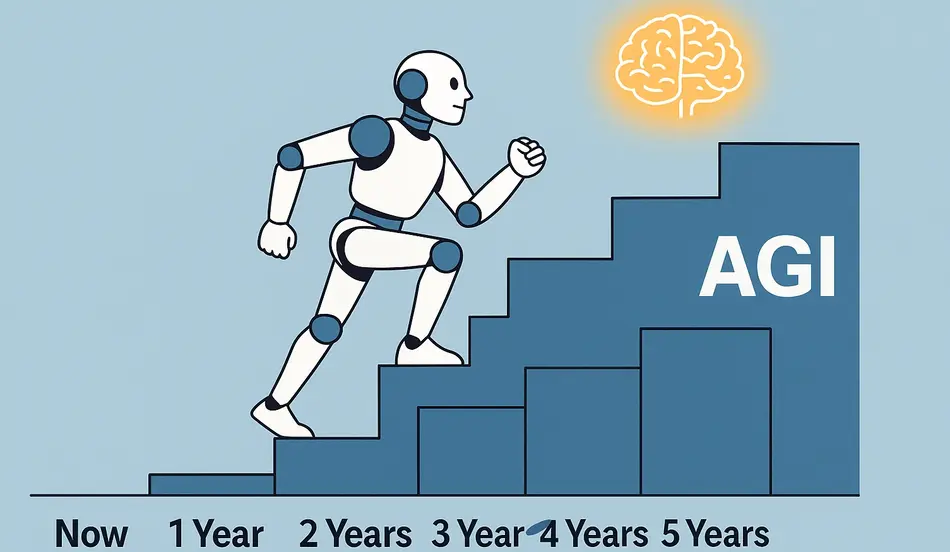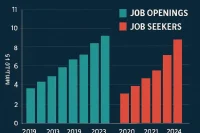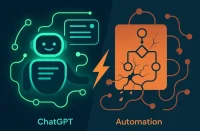The race toward Artificial General Intelligence (AGI) is accelerating at a breathtaking pace, with Google DeepMind CEO Demis Hassabis revealing we could be just five years away from achieving this technological breakthrough. In a revealing interview with Wired, the Nobel Prize winner and DeepMind founder shared unprecedented insights into AGI development timeline, safety concerns, and how this revolutionary technology could transform our world in ways we can barely imagine.
AGI Development Timeline: Closer Than We Think
When DeepMind was founded approximately 15 years ago, Hassabis and his team set out on what they considered a 20-year mission to solve intelligence and then use that intelligence to solve everything else. According to Hassabis, they’re “pretty much dead on track” with that timeline.
“I think in the next five to 10 years, that would be maybe 50% chance that we’ll have what we define as AGI,” Hassabis stated confidently during the interview. This timeline puts us potentially just half a decade away from a technology that could fundamentally reshape human civilization.
Defining True Artificial General Intelligence
While some AI leaders are suggesting AGI could arrive in as little as two to three years, Hassabis emphasizes the importance of clear definitions. As he explains, his co-founder Shane Legg helped define the term AGI back in 2001, describing it as “a system that has the ability to exhibit all the cognitive capabilities we have as humans.”
The reference to human intelligence is crucial because, as Hassabis notes, “the human mind is the only existence proof we have that general intelligence is possible.” For a system to truly qualify as AGI, it must demonstrate generalization across all cognitive domains.
Current AI Systems: Impressive But Incomplete
Despite remarkable achievements in specific domains, today’s AI systems fall short of true general intelligence. Hassabis points to significant gaps in reasoning, planning, memory, and creativity:
“Today’s systems can do International Math Olympiad problems to gold medal standard with our AlphaFold system. But on the other hand, these systems sometimes still trip up on high school maths or even counting the number of letters in a word.”
This inconsistency reveals that current AI systems aren’t fully generalizing yet—a key requirement for true AGI. According to Hassabis, this lack of consistency across different cognitive tasks is one of the main reasons we haven’t achieved AGI yet.
The Global Race for AGI Supremacy
The interview touched on concerns about the geopolitical implications of AGI development. While some experts like former Google CEO Eric Schmidt suggest that whichever nation achieves AGI first might gain an insurmountable advantage, Hassabis is less convinced of this “hard takeoff” scenario.
“That’s sometimes called the hard takeoff scenario, where the idea there is that these AGI systems, they’re able to self-improve, maybe code themselves future versions of themselves,” Hassabis explains. “So what would be a slight lead, let’s say a few days, could suddenly become a chasm if that was true.”
However, he acknowledges that there are many unknowns, and the development could be more incremental. What’s certain is that the values and norms of the designers and their culture will be imprinted on these systems, making the international dimensions of AGI development critically important.
According to research from the Future of Life Institute, the values embedded in early AGI systems could have profound implications for how these technologies develop and are deployed globally, potentially locking in certain approaches for generations to come.
Safety Concerns: Racing Toward AGI Responsibly
The interview highlighted the intense pressure and competition in the AI field today. Hassabis acknowledged two major risks that concern him:
- Bad actors repurposing general-purpose AI technology for harmful ends
- Technical risks as AI becomes more powerful and agentic
“It’s a very intense time at the moment in the field,” Hassabis admits. “There’s so many resources going into it, lots of pressures, lots of things that need to be researched.”
The tension between commercial imperatives, national security concerns, and safety considerations creates a complex landscape for AGI development. While Hassabis remains optimistic about overcoming technical challenges given enough time and care, he worries that “the geopolitical questions could be actually end up being trickier.”
The Need for International Cooperation
Hassabis continues to advocate for “smart regulation” around increasingly powerful AI systems, though he emphasizes that such regulation needs to be international in scope.
“These systems are going to affect everyone, and they’re digital systems,” he explains. “So if you sort of restrict it in one area, that doesn’t really help in terms of the overall safety of these systems getting built for the world.”
The challenge, according to experts at the Center for AI Safety, is developing governance frameworks that can adapt to rapidly evolving capabilities while ensuring international coordination on safety standards.
The Future of Work in an AGI World
One of the most pressing questions about AGI concerns its impact on employment. While Hassabis acknowledges that AI will significantly change the job landscape over the next 5-10 years, he remains optimistic about the transition.
Short-Term: AI as Productivity Enhancer
In the near term, Hassabis sees AI primarily as a productivity booster: “For the next few years, it’s most likely to be that we’ll have these incredible tools that supercharge our productivity, make us really useful for creative tools, and actually almost make us a little bit superhuman in some ways in what we’re able to produce individually.”
He suggests this could usher in a “golden era” of human productivity and creativity, with AI augmenting rather than replacing human capabilities.
Long-Term: Human-Centric Roles
Even with AGI, Hassabis believes many roles will remain distinctly human: “Maybe a doctor and what the doctor does and the diagnosis, one could imagine that being helped by AI tool or even having an AI kind of doctor. On the other hand, like nursing… I don’t think you’d want a robot to do that.”
He points to the human empathy aspect of many professions as something that will continue to be valued even in an AGI-enabled world.
Hiring?
Post remote jobs for free on WhatJobs – Find qualified candidates ready to work from anywhere.
Post a Remote Job NowPreparing for an AGI Future
For students and professionals concerned about their future in an AGI world, Hassabis offers practical advice: become proficient with AI tools now.
“The most productive people might be 10X more productive if they are native with these tools,” he suggests. His recommendations include:
- Study STEM and programming to understand how AI systems are built
- Learn to modify and customize open-source models
- Master skills like fine-tuning and system prompting
- Apply these tools to your existing work and research
According to a recent McKinsey Global Institute report, workers who can effectively collaborate with AI systems are likely to see their productivity and earning potential increase dramatically in the coming decade.
Radical Abundance: The Long-Term Vision
Looking 20-30 years into the future, Hassabis paints an optimistic picture of what he calls “radical abundance” – a world where AGI has solved many of humanity’s most pressing challenges.
Solving Root Node Problems
Hassabis envisions AGI tackling what he calls “root node problems”:
- Curing diseases and extending healthy lifespans
- Discovering new energy sources like room-temperature superconductors and fusion
- Solving resource constraints like water access through energy-efficient desalination
These breakthroughs could fundamentally transform our relationship with scarcity and potentially shift humanity from a zero-sum to a non-zero-sum mindset.
Beyond Current Economic Models
Hassabis suggests that current economic theories may be inadequate for a post-AGI world: “My view is that once you get to that sort of stage of radical abundance and post-AGI, I think economics starts changing, even the notion of value and money.”
He calls for economists to develop new theories that can account for the unprecedented abundance that AGI might enable.
Explore job opportunities in artificial intelligence research on WhatJobs
FAQ About AGI Development Timeline
What is the current timeline for achieving Artificial General Intelligence (AGI)?
According to Demis Hassabis, CEO of Google DeepMind, there’s approximately a 50% chance we’ll achieve AGI within the next 5-10 years. This AGI development timeline aligns with DeepMind’s original 20-year mission that began about 15 years ago. While some AI researchers predict AGI could arrive in as little as 2-3 years, Hassabis emphasizes that true AGI requires consistent performance across all cognitive domains—something current AI systems haven’t yet achieved. The timeline remains uncertain due to numerous technical challenges that still need to be overcome, particularly in areas like reasoning, planning, memory, and true creativity.
How will AGI development timeline affect international competition and security?
The AGI development timeline has significant geopolitical implications, with concerns that whichever nation achieves AGI first might gain a decisive advantage. Some experts describe a potential “hard takeoff” scenario where a slight lead in AGI development could rapidly expand into an unbridgeable gap if systems can self-improve at accelerating rates. Hassabis notes that early AGI systems will likely reflect the values and cultural norms of their creators, making international cooperation on safety standards crucial. The compressed AGI development timeline is intensifying competition between nations and companies, potentially compromising safety considerations in the rush to be first. This highlights the need for international governance frameworks that can adapt to rapidly evolving capabilities.
What are the main safety concerns regarding the accelerating AGI development timeline?
The accelerating AGI development timeline raises two primary safety concerns according to Hassabis. First, there’s the risk of bad actors repurposing general-purpose AI technology for harmful purposes, whether individuals or rogue nations. Second, as AI systems become more powerful and agentic, ensuring robust guardrails becomes increasingly challenging. The compressed AGI development timeline leaves less time to develop and implement safety measures, potentially forcing developers to address safety issues reactively rather than proactively. Hassabis advocates for international cooperation on “smart regulation” that can evolve alongside AI capabilities, though he acknowledges that geopolitical tensions make such coordination difficult. The race to develop AGI creates pressure to prioritize capability advancement over safety research.
How will the AGI development timeline impact the future of work and the economy?
The AGI development timeline suggests significant workforce transformation within the next decade. In the short term (next 5 years), Hassabis predicts AI will primarily augment human capabilities, potentially making individuals “10X more productive” if they become proficient with these tools. This phase represents an opportunity for workers to leverage AI as productivity enhancers. As the AGI development timeline progresses toward true general intelligence, more profound economic shifts will occur, though Hassabis believes many roles requiring human empathy will remain distinctly human. Beyond the 20-year horizon, Hassabis envisions “radical abundance” where AGI solves resource constraints, potentially transforming economic systems beyond current models. The compressed timeline emphasizes the urgency for workers, businesses, and policymakers to prepare for these transitions.
The race toward Artificial General Intelligence represents one of humanity’s most consequential technological pursuits. As Demis Hassabis reveals, the AGI development timeline may be shorter than many realize, with profound implications for our economy, security, and society. While the challenges are significant, the potential benefits—from solving disease to creating unprecedented abundance—offer a compelling vision of a transformed world. The question remains whether we can navigate the complex technical and geopolitical challenges to ensure AGI development benefits humanity as a whole.




